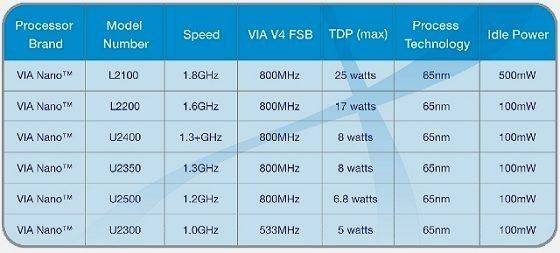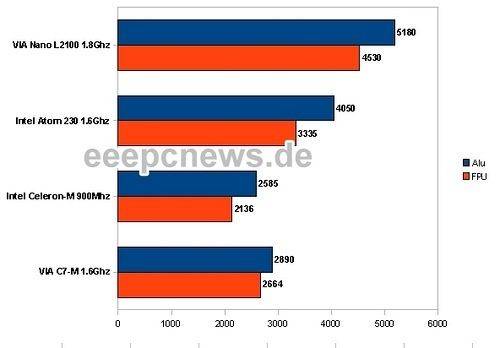Many of us have been anxiously waiting for news about the VIA Nano (formerly Isaiah) processor from VIA. Previous leaked info indicated a 2-4x improvement in processing power for a similar power drain over the older VIA C7 processors and with the Atom processors barely improving on the previous platform in terms of processing power, pro-mobile users were looking for something to fill the high-end gap.
Eeepcnews.de have been testing, (yes, they had one in their hands!) a 1.8Ghz version of the Nano CPU which isn’t the CPU we’d be looking for in UMPCs but the results give us some new data points. Firstly, here’s the model range. (test results after the image…)
In UMPC-land we should expect to see the 1.0Ghz and, perhaps, the 1.2Ghz device. Nothing more in an enclosed UMPCs. Netbooks, with their split screen/processor design, could probably take the 1.3Ghz versions.
So, to the tests. First thing we have to remember is that the old C7 was never the high-end performer and 2-4 times the processing speed doesn’t create a scorcher of a CPU. In the results, you can see that the 1.8Ghz Nano is close to double the performance of the old 1.6Ghz C7-M and about 50% ahead of the Intel Atom at 1.6Ghz. Power usage for the 1.8Ghz part is quite high though. Way too much for any mobile device except traditional, largish laptop.
Scaling the figures down, you could say, although this is very fuzzy theory, that the 1.0Ghz CPU is going to have 0.55 times the processing power bringing it right down to Celeron M, 900Mhz territory, about what you’ll see in an Atom Z-series at 1.1Ghz or the old 1.6Ghz VIA C7 but that theory probably doesn’t work with out-of-order processors and a slower FSB. The previous leaked Isaiah 1.0Ghz test results indicated slightly better results.
At the end of the day, there’s not much in it between Atom and Nano. The two CPUs, for the average user, are going to yield similar results across the range with the Nano probably turning in slightly better test results. As we’ve talked about before, the interesting thing about the Nano is it’s pin-for-pin upgrade path, its open ecosystem and its price. For the consumers, it effectively means that there’s one less thing to worry about when choosing a ultra mobile PC as the theoretical results are just too close to be able to make any decisions on.
No details about availability were given in the article.
Thanks EeePCNews.de













Interesting.
But you also have to take the chipset into account. i hope that via has some improvements here soon. And also a better driver support…
And thn there is still the big question mark about availability. Judging from former experience with via, it could still take some time.
Don`t get me wrong: I ‘like’ via, simply because I believe in competition, but I doubt they are going to really compete against intel.
I agree, the Nano is great but the chipset is classic Via: crap. Where is NVidia?
now to get those displays to not beam to much power away…
oh, and the radios to…
don’t forget the restrictions about atom: “Vendors are not allowed to build Atom motherboards with PCI Express, digital video outputs or more than one memory slot […] VIA on the other hand is openly courting board manufacturers to put as much technology on a mini-ITX design as they can – as long as they DO build one” @ PC Perspective
Then why Atom based EeeBox HAS a DVI port? I’d not be so sure about low price of Nano/VIA based solutions either. The last time I had been looking the D945GCLF was going for much less than VIA’s stuff.
Looking at Nano realistically isn’t it just catching up to old Celeron-M series?
and also, hp mininote is via based… if hp decides to pump it up, you know what will happen… afterall, they’re the biggest pc manufacturer of the world. that would really give via some boost…
let’s wait and see!
Those Nano’s burn a lot of Watts at anything above 1.3GHz though. Imagine an extra 15-23 watts in an SC3-like design, like the recent D4 test it would run out of power really quick.
I don’t see things improving until the manufacturers adress the whole system. Its partly excusable in the cheaper devices (even just the SC3 & M912) but even the expensive devices lack coherent design.
Actually Nvidia is supposed to be releasing a version of their new mobile tegra chipset to offer a higher end gpu to ultra mobile devices and is supposed to pair this off with the nano processor. They stated that the chipset will support vista, dx10, blu-ray and 1080(p or i, I can never get those things straight). Anyways, they announced this a month or so ago and stated an overall production cost of $45.00 (a bit out there, but I’m keeping my hopes up). They had the tegra chipset running crisis (on mini settings mind you) and showed some impressive results. Hopefully they’ll be posting more on the via-nvidia soon, but I haven’t seen any new updates lately.
I stand corrected, here’s the latest updated, a few weeks old though. Looks a bit dissappointing :(
http://www.techpowerup.com/65155/NVIDIA_Could_Dump_VIA_for_Intel_Atom.html
A nano 1.8GHz will never go into a netbook, too high of a TDP aka way too hot at 25W TDP. The mini-note has a 1.6GHz C7-M at 8W TDP and it already gets extremely hot. Realistically only the 1.2GHz and 1.3GHz Nano would go into a netbook, and at those speeds they aren’t any faster than Atom at 1.6Ghz and cost substantially more to manufacturer given nanos much larger die size. I’m not sure what price VIA is selling nano at, but I know Intel is charging alot for the 1.6GHz+ Atoms (when compared to the $6 manufacturering costs) so unless Nano is the same price or cheaper than Atom (doubtful), I can’t see any reason to put Nano in a netbook, especially since Intels graphics solution is much better than VIAs.
Poor VIA, when the C7 performance is worst than the Celeron, everyone call it a crap.
When the Nano beats Atom in performance, suddenly the power consumption factor is taken into considerations, and it’s still a crap.
My suggestion is trying to sell the company to Nvidia to give it another hope.
Hanzo,
It is not only power draw needed to execute a task that is important but the time period of drawing that power while executing the task as well that will actually affect your battery life. So that you can know the total amount of energy drawn during the completion of the task.
Ryan Shrout the editor of PC Perspective actually did some sample tests of measuring power usage over time comparing the VIA Nano and Intel Atom:
“Using the same method to gauge the results of our CineBench 10 test, we find that the VIA Nano used 63,434 watt-seconds (Joules) of energy to render the scene while the Intel Atom used 65,893 watt-seconds (Joules) of energy – an advantage of 3.8% to the VIA CPU.
These kinds of power comparisons are incredibly insightful and you can clearly see how both teams of CPU designers have made trade offs for the either power consumption or speed. The VIA Nano L2100 is able to perform these tasks faster (by as much as 30% in some cases) while still using less total energy than Intel’s Atom. ”
http://www.pcper.com/article.php?aid=597&type=expert&pid=8
So in most “real world” usage scenarios… Nano also beats Atom with less power consumption.
Power consumption/TDP/ is a tricky area that most people don’t understand well.
Competition for this 25W VIA is Celeron 220 (Intel D201GLY2A board), not Atom. Interested in comparison of this VIA board and D201GLY2A
Not the “little valley” with the celeron-m is the main competitor for the 1.8Ghz Nano (and its upcoming mainboards) but the “little falls” with the Atom 1.6Ghz 230. (i think celeron-m should be also eol pretty soon)
I had the little valley for testing and also the little falls (detailed comparison is coming up) but when i compare them to the Nano reference design, i would go for the Nano. The features of the cpu and the chipset are boosting up your overall performance quite a lot (compared to the 2 intel mini-itx solutions).
The board itself is way better equipped (PCIe, 2 memory slots, etc.) and even though we are always comparing hundrets of benchmarks, i can tell you it even feels faster on any desktop!
To really feel a difference in performance of a system on the desktop, you need to have an overall difference of some 20%.
Anyways, this is their first generation of this new architecture and it is a very promising start. The Nano is – when we just look at the features – at least one generation ahead of the Atom, now let’s see which devices will feature it and how the U-series will look like, especially the U2400.
I found the explanation of Intel’s “Hurry up and get idle” power consumption strategy for when they launched the Centrino to explain its …er … power efficiency.
“Another part of Intel’s push for energy efficiency is the idea of “hurry up and get idle”. Basically, this describes the theory that even if a processor uses more power at load than another CPU, if it can get the work that needs to be done completed a certain amount faster than the less power consuming CPU, the former will actually use less TOTAL power and thus bring you longer battery life in the long run.”
http://www.pcper.com/article.php?aid=591&type=expert
If you apply the hurry up and get idle theory to VIA Nano and Intel Atom…. VIA Nano does draw less power to do tasks and will be better for battery life as evidenced here:
http://www.pcper.com/article.php?aid=597&type=expert&pid=8
Cheers,
Tim
A relay want to buy a UMPC with a VIA Nano CPU, a 10″ screen and a 80-160 GB harddrive. Waited all summer!
Not only for it’t CPU but also for it’s better GPU and probably better sound-chip compared to Intel Atom UMPC’s.
But I just can’t wait any longer!
No news from VIA when we will see a VIA UMPC on the market in the EU?
The MSI Wind is released in Sweden this week (long over due I know). So if I’m lucky a could get a VIA Nano UMPC just before Christmas or probably next year. :(
Or a could order a MSI Wind NOW!!!